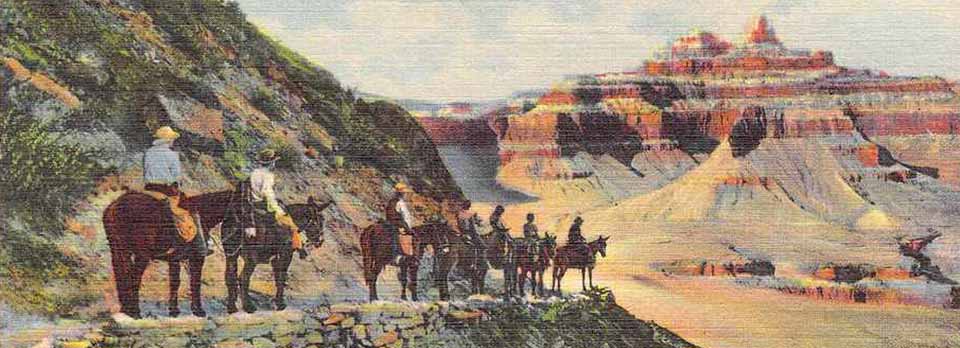
I encourage everyone to visit the Grand Canyon, as it is truly one of the wonders of the world. Yet despite the efforts of the national park's staff to explain the canyon and environs in detail, much of the true nature of this place remains untold. In that vein, I offer the modern visitor some of the lessons learned during my three month stay here at the South Rim - geographic, geologic, and biological. Oh, yes – and meteorological.
You will quickly become aware of the vigorous wind here on most days, and you’ll then notice that unwary folks are likely to lose their headgear. From Yankee baseball caps to expensive Stetsons, any hat not on tightly is in constant danger of migrating outward and downward.
Rest assured, the NPS has things under control. At great cost of time and effort, each December the Rangers scour the inner canyon for lost headwear. Yes, there is no danger of millinery litter here. Thousands of hats, many like new, will become available afterwards, with the proceeds going to help the park. I’m sure you’ve heard that Park Service funding has decreased for a decade, not increased. I might point out to the uninitiated, those flat Ranger hats have a strap that helps keep them on – no glue is involved.
One of the foremost places to lose one’s cap is, of course, Selfie Point near the Visitor Center. Little known fact - the large rectangular rock at this popular overlook, usually enhanced by a tourist on top in an overly dramatic pose, was placed there specifically to increase hat distribution. By the way, given the fact that printed photographs have become passé, just the photos from Selfie Point alone would have long ago cost the world enough paper to have used up the entire Ponderosa Pine forest on the North Rim. So thank goodness for cell phones and egos.
From Selfie Point many visitors walk the Trail of Pennies to the Geology Museum at Pizzapai Point. In this intricately created exhibit, each penny in the paved path equals a million years. You have to see it to believe it. Geologists have now confirmed that the rocks in the Grand Canyon, despite the presence of abundant coprolites, were formed from very, very old mud and not Kitty Litter as previously thought.
This short route is also a good way for newcomers to experience the PBJ forest, made up of Pinyon Pines, Juniper, and Butterscotch. Pinyon, Butter and Juniper sandwiches are always available at the Market (also a good place to purchase a gently used hat).
More adventurous visitors take the hike to Ooh Aah Point, a mile or so down the Shish Kaibab Trail. The name “Ooh Aah” is part of the canyon’s history, a relic from an earlier age when semi-crippled gentlemen, having reached this spot, would tear off their cowboy boots howling in pain. It was about this time that mule rides became a popular way to experience the inner canyon.
FYI - Today those who wish to walk down into the magnificent gorge are encouraged to first use the facilities at Hermit’s Rest Room.
Botany fans come to the Grand Canyon looking for the Banana Yucca. This plant should not be confused with the Pineapple Cactus or the Pancake Pear, though all three are pollinated by the Watermelon Bug.
On to zoology. The Pronghorn Cantelope is a rare sight at the Grand Canyon. They prefer open, flat prairie, an ecosystem in short supply here. You are more likely to encounter the Elkamino, a large forest ungulate whose preferred habitat is the grassy median. Elkamino jams are common, as people stop to photograph the animals – I’ve seen enough Elkamino jams now to last me the rest of my life. Speaking of which, the other thing that I can’t get out of my mind is the insistence of people on having their picture taken with Smokey Bear. As a reminder to visitors, Mickey and Goofy are SOMEWHERE ELSE.
Many people come wanting to see the reintroduced California Condor. Our best advice is to follow the garbage truck on its way to the dump, particularly after El Tovar has served a lot of Elkamino Chili. Condors, as you know, are scavengers. The Ring-tailed Cat can be seen at El Tovar as well, running along the rafters in the dining room. A harmless animal, yes, but smart diners don’t dally over their Mormon Tea.
The National Park Service would have us believe that the Rock Squirrel, responsible for the most visitor bites, is the most dangerous animal in the park. Actually, that honor goes to inexperienced RV drivers. Easy to spot, their oft-rented travel trailers have huge color murals of the Children of the Corn on the sides, smiling evilly, as a warning to pedestrians.
That sums it up; glad to help. From here on, you’ll have to make up your own information. Hope you enjoy your visit as much as I did mine.
Return to Inspiration Point Blog Index Page.
This blog is meant to encourage awareness and thoughtfulness about the Grand Canyon, one of our most precious resources. It is not merely a story of what happens or has happened here, not a cookbook for what you should make of it yourself, but more an example of the many-faceted inspiration the Canyon nurtures in an artist, perhaps in you. Indeed, inspiration may be the Canyon's greatest resource.
These words are sincere, my own take on this world, deliberately non-academic and directed toward users of social media. In no way does it represent the policies or opinions of the National Park Service, although it is done under the auspices of that entity, but is offered in gratitude, with my respect and admiration for these soldiers of conservation. George H. Jacobi 2016
